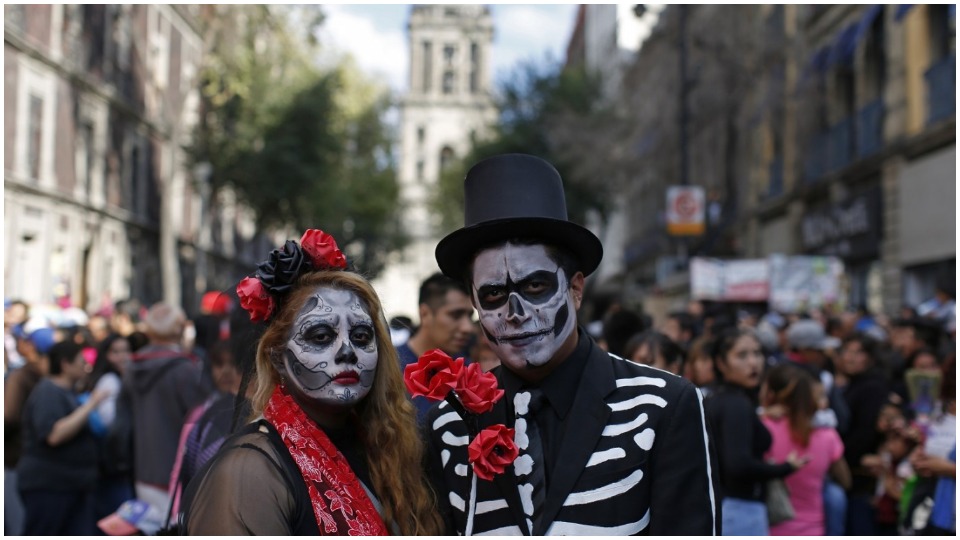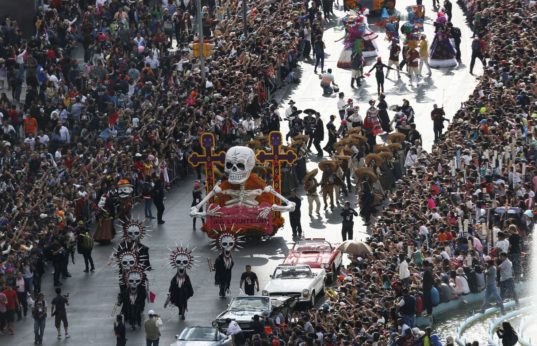
The marigolds had recently been planted on Paseo de la Reforma when I visited Mexico City in mid-October. The Mexican marigold is called the cempazuchitl, “the flower of the dead.” It’s symbolism is complex. The flowers are believed to help guide the dead to altars in public burial spaces and private homes where loved ones will honor them on Nov. 2, Día de Muertos, or the Day of the Dead—more properly, part of the “Days of the Dead” that begin Oct. 31.
Over the last decade, the United States’ current version of Halloween—an $8 billion-dollar-a-year industry now entwined with behemoth entertainment franchises—has launched an invasion of Mexico. In many of the largest open air markets in Mexico City, it’s likely you’ll see characters from the latest and most popular Disney or movie franchise rather than the traditional skeletons in effigy known as calaveras. In fact, images of the Avengers beat out the masks of legendary luchadors like the Blue Demon and Eddie Guerrero.
Superhero franchise costumes are at least as common as sugar skulls in the markets of the now upscale Coyoacán neighborhood. Mexico has a thriving horror film industry and yet major Hollywood horror films like IT and the Annabelle series reign. Both seem to compete for the majority of pesos, with John Carpenter’s Halloween running a distant second to both.
Ad campaigns by Coca-Cola and McDonald’s have used Halloween to help their sales. Coca-Cola is the most popular drink in Mexico; since it became more affordable following the 1994 NAFTA trade deal, it’s even more popular than in the United States. In a country where safe drinking water remains a major political issue, Coca-Cola has cashed in. The Golden Arches, long an international symbol of the spread of U.S. capitalism, has also used the North America (del Norte) concept of Halloween to sell its products.
Capitalism vs. the calaveras?
Día de Muertos is not “Mexican Halloween.” Street food vendors near the Plaza de la República described the holidays to me in mystical terms as an apertura de un portal, the opening of a portal. As in many cultures, it’s a time not only when the dead are honored—they visit you. One young man, originally from Costa Rica but a Mexican national, assured me that Oct. 31-Nov. 2 becomes a moment when a door opens to the other world and that even pets who’ve passed away cross the bridge from the world of death.
It’s an enchanted idea, even if one is understandably skeptical of the uses economic elites generally put to supernatural beliefs. But there’s no doubt that the rituals surrounding las Días de Muertos are entwined with Mexico’s history and folklife. Although very much Christianized over half a millennium, its roots were sunk in the centuries before the coming of the Spanish conquerors.
David J. Skal, a historian of horror and culture who authored Death Makes a Holiday: A Cultural History of Halloween, sees the practices surrounding the Days of the Dead as the very opposite of middle-class U.S. efforts to keep death at “a controlled distance.” In Mexico, graves are decorated and cleaned, gifts are left of things enjoyed in life—flowers, favorite foods, favorite mezcal. What Skal describes as the “elaborate shrines” that appear in homes, called ofrendas, both honor the departed and welcome their presence. The tolling of bells and candlelight join the marigolds guiding the spirits who making their way to these home altars.
The Days of the Dead take the Mexican people back to the bare bones, literally, of existence. The realities of life and death are not ignored but embraced.
Indeed, the social realities of Mexico are on display on the days that death reigns. The Catrinas are one of the most popular symbols. These are skeletons dressed in their finest—grim but meaningful reminders that class status (and gaudy aspirations to a higher class status) are truly doomed by the material conditions of human life—the reality that we all die.
But the United States hovers over all. Over the last six years, Mexico City resident Jessica Esquivias has been worried enough that she launched an effort to rejuvenate the tradition of the Day of the Dead. France 24 reported last fall that she had organized thousands of parade-goers to paint their bodies and faces as Catrinas and march through Mexico City on Nov. 2. Esquivias sees this as both returning to older traditions and as a “political and social satire” of “U.S.-style Halloween celebration.”
Should socialists even care?
The dynamics of global capitalism provide the simple explanation for why the corporate attempt to seize the Days of the Dead. Coca-Cola, McDonalds, Disney, and others decided to take a slice of the Days of the Dead, so they’ve taken it. Karl Marx often emphasized the fluid and nearly unstoppable movement of capital, how it seemed to rush forward and overflow any barriers raised against it, circulating like rivers running to the sea. It’s a lovely metaphor unless, as Marx well knew, you are drowning.

So is the invasive and acidic nature of capital anything remarkable? Does criticizing the way that Mexican kids are buying into Marvel’s and Disney’s cast of characters really function as anything more than a lament that when middle-class U.S. tourists visit Mexico City it is Iron Man or Pennywise who might greet them instead of some Instragram-worthy sugar skulls?
Perhaps it’s a political error to lament the denigration of even an ancient tradition. Anglo-liberals might wax sentimental over the encroachment of U.S. corporate culture into Mexico largely because they wish to see the “exotic,” indeed what the more blinkered might perceive as the “primitive” aspects of Mexico’s tradition preserved for their own enjoyment next time they visit.
Moreover, its’ perhaps easier for an outside observer to romanticize the holidays than it is for the Mexican people, even those with much love for their traditions. Although the celebration largely detached itself from Mexico’s powerful Catholic hierarchy in the 20th century, the sheer size of the festival suggests the Church has long profited from its rituals. The Church had, for centuries before the revolution, enriched itself as one of the major landowners in the country. At the very least, it seems the Church receives residuals during the Days of the Dead.
But an important political question connected to Mexico’s history plays a role in this discussion. As historian and novelist Pasco Ignacio Taibo II has described in his work Patria, the effort to create a sense of “a nation” or “a people” has been absolutely necessary in the country’s struggle for political liberation. The sense of the struggle for national liberation, born in the aftermath of the U.S.’ invasion of Mexico (and seizure of nearly half its territory) and the French/Hapsburg intervention of the 1860s, formed the background for the Mexican Revolution (1910-20) and its aftermath.
On the other hand, for socialists, the Day of the Dead might look at first glance exactly like the kind of “nationality” ethnocentrism Lenin warned about in Critical Remarks on the National Question. Slogans, and anxieties, about “national cultures,” he warned, are really tricks played by the bourgeoisie to get workers of all ethnicities to do their “dirty and reactionary work.” Lenin seems to have known little about Mexico and yet could have been describing it when he writes in Critical Remarks of how every national culture includes a “bourgeois” culture with firm ties to landowners, the Church, and the police.
In the last analysis, worrying about the death of national and cultural traditions is no more than taking nervous notes on the acidic properties of capitalism itself. Indeed, in the case of persecuted nationalities, and nations, Lenin worried that the preservation of national culture could be especially distracting, allowing the middle classes to “stultify” the workers.
There’s international proletarian internationalism or there’s bourgeois nationalism, Lenin seemed to say. Pick a lane.

But, in fact, the question is not so simple, and the case of Mexico reveals this point. Commercial franchises taking over the Days of the Dead arguably threaten to rob Mexican culture of the one place Lenin did think “nationality” could play a role. He allowed for the possibility that a national culture could have “socialist and democratic elements” much needed by any leftist movement on behalf of workers.
Certainly Mexico exhibits just this. The anti-clericalism of the revolutionary years did take the Days of the Dead outside of the province of the Church. Communist and leftist artists like José Guadalupe Posada and later Diego Rivera seem to have been attracted to the imagery of the holiday precisely because it drew so heavily on the culture of the worker and the peasant. Using Days of the Dead imagery in the popular press and making it a symbol of the revolution that inspired Pancho Villa and Emiliano Zapata mark Posada’s final years.
There are two lessons we can pass on from the attempt to Americanize the Days of the Dead. First, North American workers can see from the experience of Mexico that elites playing with either free trade agreements or tariff wars could care less about what’s meaningful to them. This awakens the possibility of solidarity beyond the hateful rhetoric of Trumpism about Mexico. A worker at a Tyson chicken factory in the Southern U.S. has more in common with a worker at a Mexico Coca-Cola plant than they do with either Donald Trump or “never Trumpers” like Bill Kristol or Mitt Romney. Or for that matter, with Amy Klobucher and Joe Biden.
Finally, capitalism is your problem. If you think the Days of the Dead…or Christmas…or your favorite entertainment franchise… has become “too commercial” as people in the U.S. like to say, your problem is capitalism. If there’s a “war” on any holiday or popular tradition, it’s not because a worker being denied a living wage at the coffee shop or Walmart didn’t wish you a “Merry Christmas.” It’s because capitalism will consume whatever you love, spit it out, and tell you that’s what you really want.
When this system is gone, its ravages complete, no one will build an ofrenda for it. No one will mourn it. No one will plant marigolds for capital.












Comments